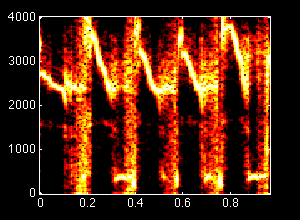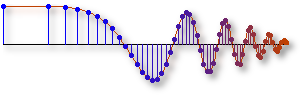Labs - LabVIEW
In this lab we introduce the fundamentals of LabVIEW. LabVIEW is
a programming environment that you will find helpful for many of
the exercises in this text.
Manipulating sinusoid functions using complex exponentials turns
trigonometric problems into simple arithmetic and algebra.
In this lab, we first review the complex exponential signal and the
phasor addition property needed for adding cosine waves.
Then we will use Matlab to make plots of phasor diagrams that show
the vector addition needed when combining sinusoids.
[Files]
The objective of this lab is to introduce more complicated
signals that are related to the basic sinusoid.
These are signals which implement frequency modulation (FM) and
amplitude modulation (AM) are widely used in communication systems
such as radio and television, but they also can be used to create
interesting sounds that mimic musical instruments.
In this lab, we will synthesize more complicated sinusoidal waveforms
composed of sums of sinusoidal signals, each with a different
frequency. The sounds synthesized will one of several songs.
[Files]
This lab includes a project on speech synthesis with sinusoids. The speech synthesis will be done with sinusoidal waveforms where each sinusoid will have short duration on the order of the pitch period of the speaker. One objective of this lab is to study how many sinusoids are needed to create a sentence that sounds good. A secondary objective of the lab is the challenge of putting together the short duration sinusoids without introducing artifacts at the transition times. Finally, much of the understanding needed for this lab involves the spectral representation of signals - a topic that underlies this entire course.
[Files]
The objective of this lab is to introduce more complicated signals that
are related to the basic sinusoid.
These are signals which implement frequency modulation (FM) and
amplitude modulation (AM) are widely used in communication systems
such as radio and television), but they also can be used to create
interesting sounds that mimic musical instruments.
[Files]
In this lab, we will synthesize more complicated sinusoidal waveforms
composed of sums of sinusoidal signals, each with a different
frequency. The sounds synthesized will one of several songs.
The objective in this lab is to introduce digital images as a
second useful signal type. We will show how the
A-to-D sampling and the D-to-A reconstruction processes are
carried out for digital images. In particular,
we will show a commonly used method of image zooming
(reconstruction) that gives poor results a later
lab will revisit this issue and do a better job.
[Files]
The goal of this lab is to learn how to implement FIR filters
in MATLAB, and then study the response of FIR
filters to various signals, including images and speech.
As a result, you should learn how filters can create
interesting effects such as blurring and echoes. In addition,
we will use FIR filters to study the convolution
operation and properties such as linearity and time-invariance.
[Files]
This mini project concentrates on the use of dconvdemo a GUI for discrete-time convolution.
This demo is exactly the same as the MATLAB functions conv() and firfilt() used to
implement FIR filters.
This demo illustrates an important point about the behavior of a linear, time-invariant (LTI) system. It also
provide a convenient way to visualize the output of a LTI system.
The goal of this lab is to study the response of FIR filters to
inputs such as complex exponentials and
sinusoids. In the experiments of this lab, you will use firfilt(),
or conv(), to implement filters and
freqz() to obtain the filter's frequency response. As a result,
you should learn how to characterize a
filter by knowing how it reacts to different frequency components in the input.
This lab also introduces two practical filters: bandpass filters
and nulling filters. Bandpass filters can be
used to detect and extract information from sinusoidal signals, e.g.,
tones in a touch-tone telephone dialer.
Nulling filters can be used to remove sinusoidal interference, e.g.,
jamming signals in a radar.
This lab introduces a practical application where sinusoidal
signals are used to transmit information: a touchtone
dialer. Bandpass FIR filters can be used to extract the
information encoded in the waveforms. The goal
of this lab is to design and implement bandpass FIR filters in MATLAB,
and do the decoding automatically.
In the experiments of this lab, you will use
firfilt(), or conv(),
to implement filters and freqz() to
obtain the filter's frequency response. As a result,
you should learn how to characterize a filter by knowing
how it reacts to different frequency components in the input.
[Files]
This lab introduces a practical application where we attempt
to extract information from sinusoidal signals -
in this case, piano notes. Bandpass FIR filters can be
used to extract the information encoded in the waveforms.
The goal of this lab is to design and implement several
bandpass FIR filters in MATLAB, and use the
filtered outputs to determine automatically which note is being played.
However, since there are 88 keys on
the piano, we will only require the system to figure
out which octave the note is in, not the exact note. In
the experiments of this lab, you will use
firfilt(), or conv(),
to implement filters and freqz() to
obtain the filter's frequency response. As a result,
you should learn how to characterize a filter by knowing
how it reacts to different frequency components in the input.
[Files]
In this mini-project you will Write a simple LabVIEW
VI that removes unwanted tones from a wav file.
The file SunshineSquare.wav has had some unwanted tones added to it.
Your job is to remove the tones so you can hear the message better.
[Files]
The objective for this lab is to build an intuitive understanding of
the relationship between the location of poles and zeros in the
z-domain, the impulse response \(h[n]\) in the \(n\)-domain,
and the frequency
response \(H(e^{j\hat\omega})\) (the \(\hat\omega\)-domain). A
graphical user interface (GUI) called
PeZ was written in MATLAB
for doing interactive explorations of the three domains.
In this mini-project you will experiment with PeZ to learn the connection
between pole-zero placement and frequency response. Given this information
you will redo the Tone Removal Mini-Project using an IIR.
[Files]
For this mini project you will write a simple function that
listens to a tone and identifies what note it is.
[Files]
For this mini project you will write a simple function that
listens to a wav file of a simple song and identifies
the notes being played.
The wav files have some simple songs on which you can practice.
[Files]
You have gotten to the point in your studies that you can
understand DSP papers that appear in IEEE publications.
The purpose of this project is to read one such paper
and reproduce some of its results.
The goal of this mini-project is to help you understand a simple modem, the FSK modem, referred to by the International Telecommunications Union (ITU) as V.21.
The goal of this mini-project is to build a simple modem receiver. This a follow on for the previous mini-project.
 1. Introduction
1. Introduction 2. Sinusoids
2. Sinusoids 3. Spectrum Representation
3. Spectrum Representation 4. Sampling and Aliasing
4. Sampling and Aliasing 5. FIR Filters
5. FIR Filters 6. Frequency Response of FIR Filters
6. Frequency Response of FIR Filters 9. z-Transforms
9. z-Transforms 10. IIR Filters
10. IIR Filters A. Complex Numbers
A. Complex Numbers